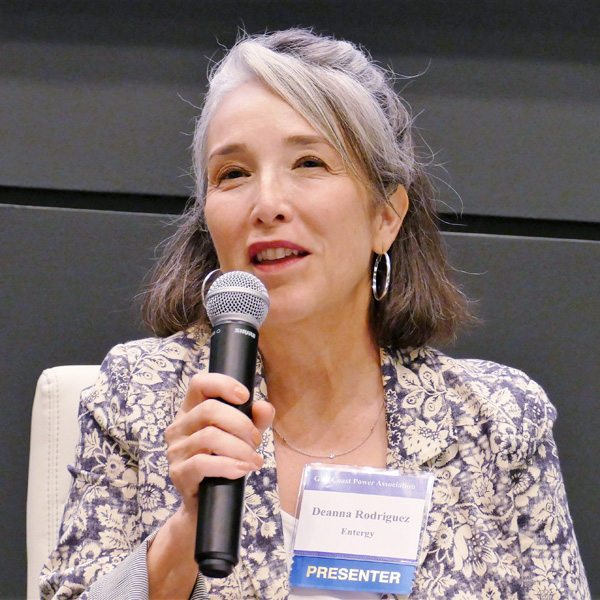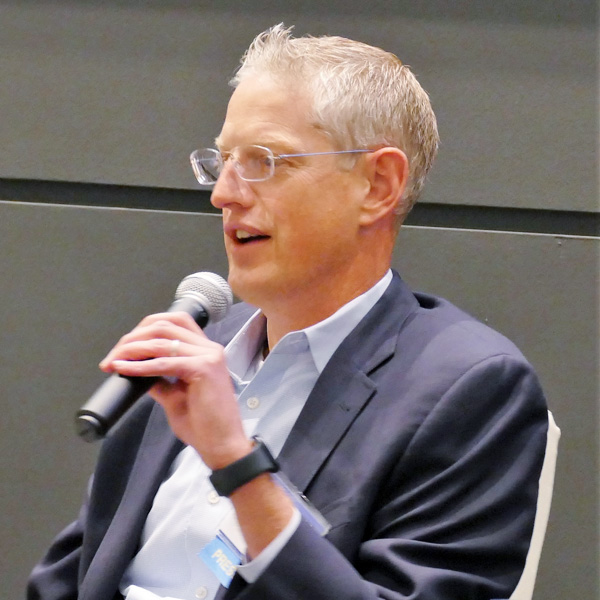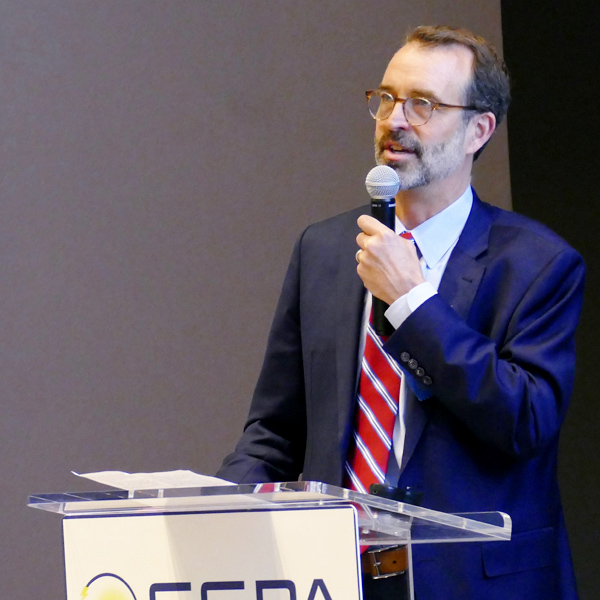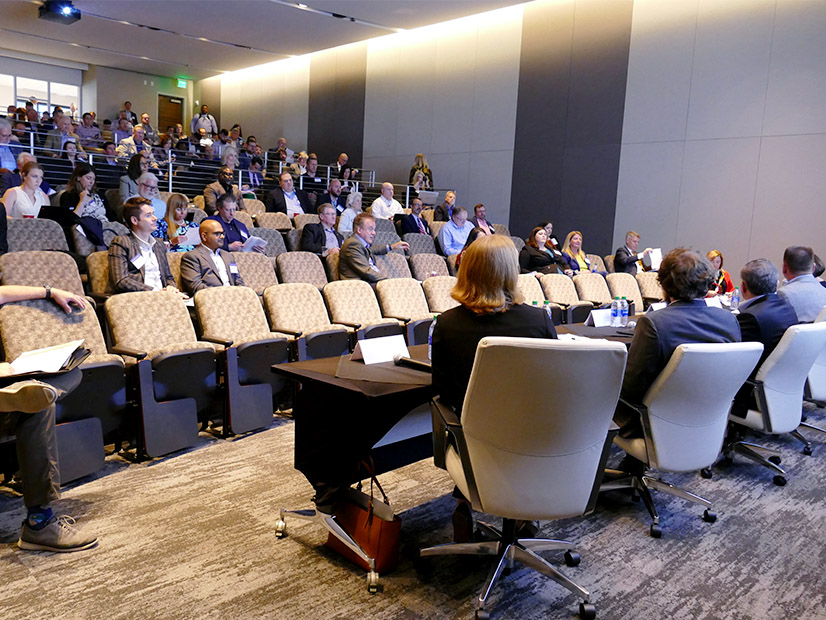NEW ORLEANS — Relationships were on the agenda last week during the Gulf Coast Power Association’s MISO South-SPP regional conference, from those among the 200 attendees who hadn’t seen each other in two years to the strong bonds now evident between the two RTOs.
SPP CEO Barbara Sugg said her most rewarding accomplishment since taking the helm in March 2020 — about the same time the COVID-19 pandemic “moved everybody’s cheese,” as she said — has been building the RTO’s relationship with MISO.
“I think one of the biggest changes that we made is that we focused on our relationship with MISO, and I can’t tell you how much how rewarding that relationship has been thus far,” Sugg said during her keynote address that opened the two-day conference. “We were trying to solve the same problems. There’s just doesn’t seem to be a reason to me why we can’t solve them together.”
Sugg said SPP must be ready for the future grid, and collaboration with neighbors is one of her organization’s goals.
“I’ve got a long list of unexpected things that have happened in the past two years,” she said, jokingly. “Don’t worry, I won’t read them to you.”
Sugg referenced the RTOs’ Joint Targeted Interconnection Queue (JTIQ) transmission study as a uniting force between them. (See MISO, SPP Finalize JTIQ Results with MISO Tx Duplicates.)
“Quite simply, we can build it separately, or we can build it together,” she said.
A day later, MISO CEO John Bear said the improved relations were as “simple as Barbara Sugg and I decided to make it a priority.” He said many down the ranks also deserved credit.
“I can’t heap enough praise on MISO and SPP for doing this,” Clean Grid Alliance’s Beth Soholt said of the JTIQ study, which she called “groundbreaking.”
“We’re just very grateful to John and Barbara.”
Bear: High Reliability, Not High Costs
MISO Chief Customer Officer Todd Hillman conducted an environmentally friendly fireside chat with Bear using a tablet’s video of a burning hearth to add warmth.
 “Fireside” chat between MISO’s Todd Hillman (left) and CEO John Bear | © RTO Insider LLC
“Fireside” chat between MISO’s Todd Hillman (left) and CEO John Bear | © RTO Insider LLC
“We don’t want to emit any carbon from a fire in the building,” Hillman said.
He asked Bear about his reaction to a recent PJM study that concluded the grid operator might need a reserve margin above 70% to accommodate a 50% share of renewables in the resource mix and satisfy a one-day-in-10-year loss-of-load expectation.
“We all want really high reliability, but we don’t want really high costs,” Bear responded. He said transmission operators must strike a balance between intermittent assets and controllable assets while building new structures, but added that MISO will strive for a more efficient reserve margin.
“Otherwise, someone else will be here talking to you next year,” Bear said.
Although gas generation remains harder to build because of grueling pipeline permitting, Bear said, MISO will continue to rely on gas-fired generation to a degree. “You can’t paint 65% of your house without scaffolding and ladders,” he said, referring to fossil generation importance during the transition.
Bear called escalating weather events an “enduring issue.” He said MISO’s seams are a “magic lever” that MISO can sometimes pull to import generation during severe weather.
Hillman asked what topic Bear would raise if he was in an elevator with President Joe Biden. Without hesitation, he said MISO must build long-range transmission projects over the decade. MISO’s $10.4 billion long-range transmission package has a nearly 3:1 benefit-to-cost ratio, the RTO says. (See MISO Updates Stakeholders on $10B Long-range Tx Package.)
Bear said if staff is to operate with a fleet awash in intermittent resources, they must be able to move the energy around when output is high or when the intermittent resources aren’t producing at high levels. He said MISO will have to look closely at how renewable resources twice the size of today’s might alter flows.
The RTO will soon reassess the need for a new set of interregional transmission projects with PJM because of the increase in renewable resources, Bear said.
Consultant Asks for Unified MISO
 Jennifer Vosburg | © RTO Insider LLC
Jennifer Vosburg | © RTO Insider LLC
“The future is coming, and we’re going to have a rough ride getting there,” independent energy consultant Jennifer Vosburg said, calling for a more unified MISO between the Midwest and South. She lamented that about eight years into the South’s MISO membership, it’s isolated from the rest of the footprint when it comes to planning.
“How many futures are we talking about? Are we talking about MISO future or a MISO South future?” she asked rhetorically. “I joined MISO. I didn’t join MISO South.”
Vosburg pointed out that MISO South is not included in the first half of MISO’s long range transmission plan (LRTP) and will not share in costs. When the South is included in long-term planning, she predicted rocky cost-allocation discussions.
A cost-allocation “Civil War,” she quipped.
Vosburg also said addressing the connection between MISO Midwest and MISO South is past due. She pointed out that because a 500-kV Dell-New Madrid line is on outage through June, MISO Midwest lacks any physical links into the South. (See MISO Midwest-South Transfer Service on Outage until July.)
“That is something we must address. It’s been long enough,” Vosburg said. “We’re planning for one MISO, but we’re operating two.”
She said while MISO South won’t see any costs from the LRTP’s first half, it also won’t see any chance for federal infrastructure funding. “I think there’s a danger there,” Vosburg said, reminding planners that ratepayers are at the other end of spending.
Undergrounding a No-go in NOLA
 Entergy New Orleans CEO Deanna Rodriguez | © RTO Insider LLC
Entergy New Orleans CEO Deanna Rodriguez | © RTO Insider LLC
Entergy New Orleans CEO Deanna Rodriguez earned the conference’s biggest laugh when describing the resilience plan the utility will file at the Big Easy city council’s request.
She said Entergy will likely stop short of “gold-plating” the infrastructure by undergrounding all power lines.
“We don’t underground our dead people in New Orleans,” Rodriguez said, a reference to the city’s iconic above-ground tombs. Because New Orleans is at or below sea level, the soil has a high water table, placing bodies buried in the ground at risk of being water-logged or even displaced.
In recent years, Entergy NOLA has been buffeted by hurricanes, severe winter weather and just recently, tornadoes. Hurricane Ida last year cut power to the entire city, and it took 10 days to completely restore electricity. Rodriguez said that the transmission structures that toppled during the storm were first tested by 150-mph winds.
She said it’s “critical” the utility get creative in making the system more resilient, including exploring microgrid technology.
“You have to look at all options,” she said.
Tx Planning a ‘Least-regret’ Approach
Aubrey Johnson, a freshly minted vice president at MISO overseeing all aspects of transmission planning, said that recent leaps in the electric industry are more dramatic than any of the 100 years that came before and require planning a system that can handle more uncertainty.
Johnson said MISO’s planning is a “path of least regrets” and quoted President John F. Kennedy in saying, “the best time to fix the roof is when the sun is shining.”
“We’re speeding to the outcome at a rapid pace. … What we should realize is, when it’s broken, it’s always harder to fix.”
 MISO’s Aubrey Johnson (left) listens to SPP’s Antoine Lucas during a panel discussion on transmission planning. | © RTO Insider LLC
MISO’s Aubrey Johnson (left) listens to SPP’s Antoine Lucas during a panel discussion on transmission planning. | © RTO Insider LLC
Antoine Lucas, SPP’s vice president of engineering, agreed that transmission planning inaction carries a hefty cost.
“We’re going to have to get more study … into the cost of indecision to get folks more comfortable with the costs of decisions,” he said.
MISO Director of Real-Time Operations J.T. Smith said he had a role in the 2011 Multi-Value Project (MVP) portfolio, the RTO’s last long-range planning effort. He said the portfolio’s only shortcoming is that it didn’t go far enough.
“We underbuilt it,” he said. Nodding to Soholt in the audience, he said, “Beth was yelling at me [at the time] that it wasn’t enough, that more wind was coming.”
Lessons from the Natgas Sector
 Steve Bruns, Tenaska | © RTO Insider LLC
Steve Bruns, Tenaska | © RTO Insider LLC
Steve Bruns, a marketing vice president with Tenaska Marketing Ventures, gave attendees and MISO and SPP staff a crash course on natural gas contracts and curtailments during a panel discussion on the fuel supply issues during the February 2021 winter storm that led to load shed in both RTOs.
SPP COO Lanny Nickell said 53% of the grid operator’s accredited gas supply didn’t show up during the storm, leading to the first load shed in the organization’s 80 years. It turned out a “surprisingly low number” of contracts were for firm fuel.
“Less than 50%,” Nickell said. “That was eye-opening.”
“I’m sympathizing with you guys because I too still have PTSD over the events that transpired during that week in February,” Bruns said. “Firm means something different in the natural gas world. Unfortunately, the electricity markets have decided to be a spot buyer, a daily buyer of commodity [regulated local distribution companies].
“The big gas utilities’ industrial customers have much more of a portfolio approach when they’re procuring gas. They’re buying first of the month; they’re buying fixed price. Yes, those are typically higher priority products that those consumers of natural gas have contracted for, and therefore the producers are going to give those contracts a higher priority level of service when they’re going through their curtailments as they’re starting to lose production.”
Gramlich Says System at ‘Breaking Point’
 Rob Gramlich, Grid Strategies | © RTO Insider LLC
Rob Gramlich, Grid Strategies | © RTO Insider LLC
Grid Strategies President Rob Gramlich said RTOs, save for CAISO, fail to proactively plan their transmission systems. He said MISO’s and SPP’s interconnection queues, largely designed to usher in natural gas and combined cycle plants, are dysfunctional when it comes to integrating the new resource mix.
“This system is really at the breaking point right now,” he said. “Low-cost decarbonization requires large-scale transmission.”
Gramlich said the future system must be able to flow tens of gigawatts of renewable power bidirectionally. “If we keep nickel and diming with generator interconnections, we’re probably going to end of paying a lot more in the long run,” he said.
Past transmission planning efforts to incorporate renewable energy, such as MISO’s MVP portfolio and SPP’s priority projects, only came up short in that they weren’t big enough, rendering wind generation curtailments today, Gramlich said.
“Let’s take that lesson, roll it forward, and do this big at the right scale,” he said.
Entergy La. CEO Looks to 2050
Entergy Louisiana CEO Phillip May said though some industrial customers were initially resistant to carbon reductions goals, they now widely accept sustainability.
“The shift is complete. Anywhere you go, that conversation is welcome, and you can roll up your sleeves and talk about it,” May said.
He said while he’s confident about Entergy’s goal to reduce carbon emissions 50% by 2030, the path to net-zero by 2050 is hazy.
“The great thing about big, audacious goals is you don’t know how you’re going to get there,” May said. “But I’m confident we’ll get to 2050 and there will be a big, quantum change.”
May said solar generation is now a “very compelling economic asset,” and that carbon capture and sequestration will likely come into play. Electrification of the Gulf Coast’s heavy industry is also on the horizon, he said.
“Increasingly, our customers’ customers are going to demand that those products be cleaner,” May said.




